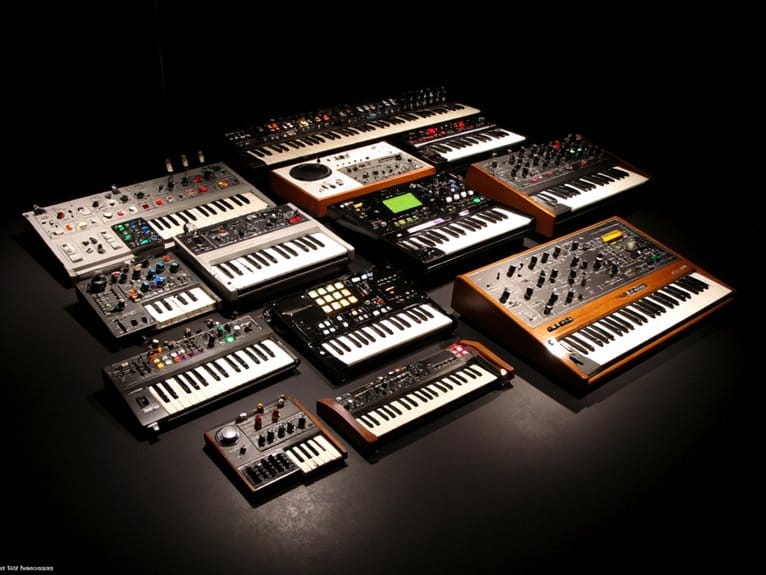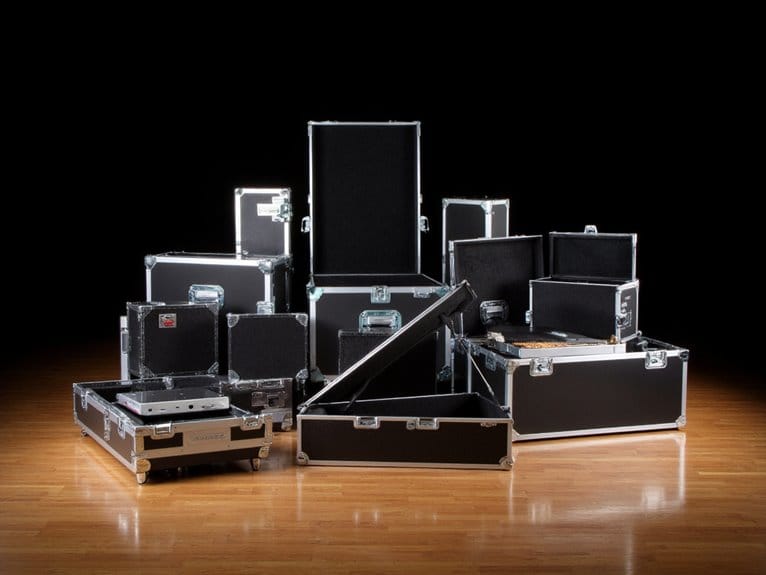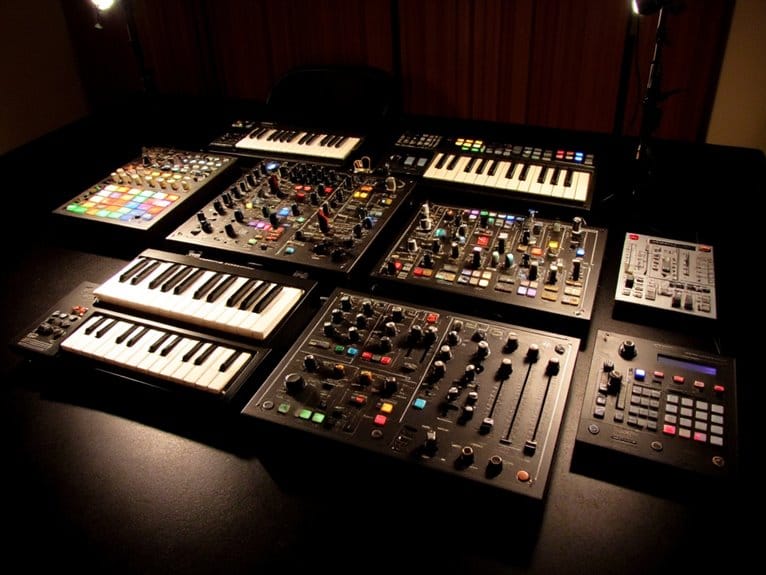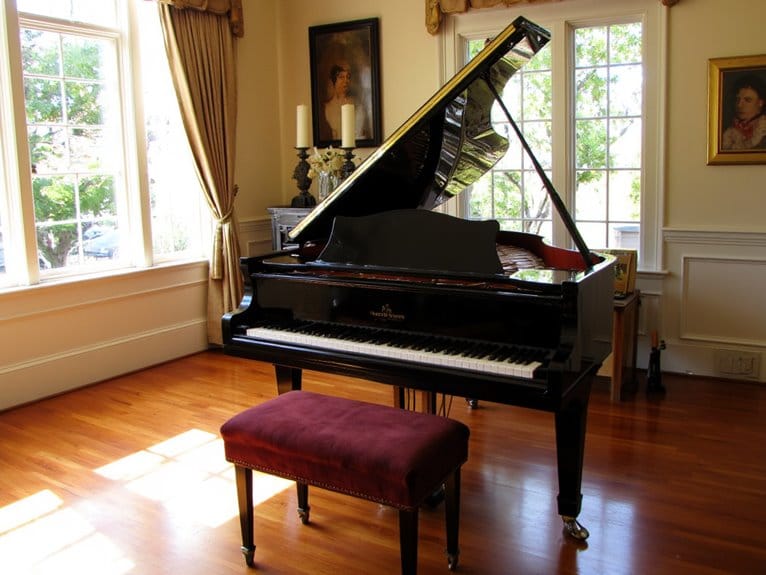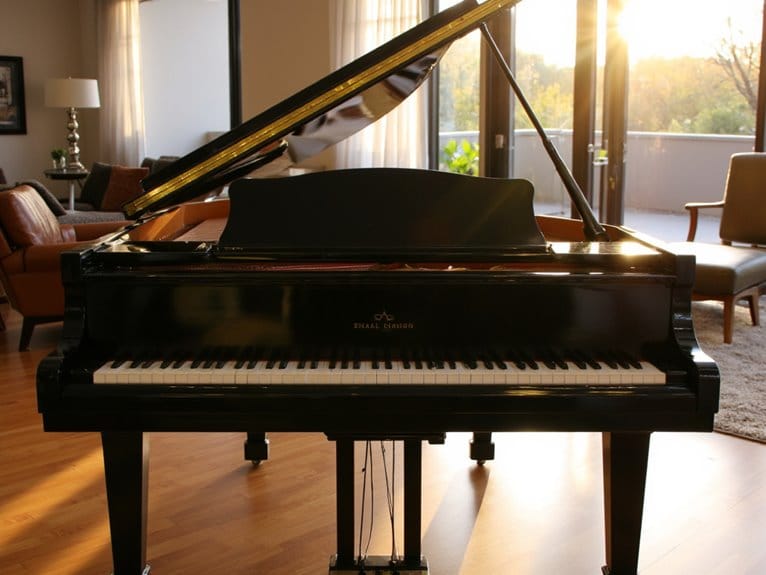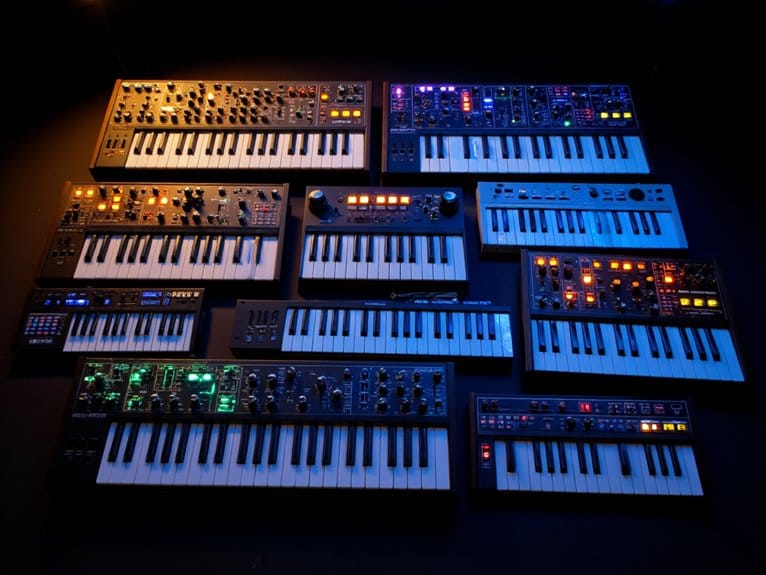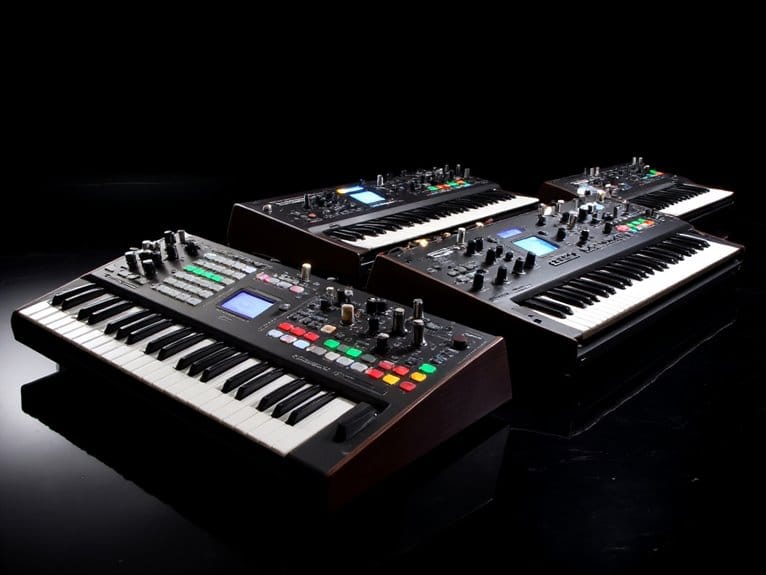10 Best Synthesizers Under $1000 for Every Music Producer
After testing dozens of synthesizers under $1000, I’ve found the Behringer Pro VS Mini stands out with its hybrid vector synthesis and compact footprint, while the TD-3-MO delivers authentic analog bass sounds perfect for acid house producers. The Korg MS20 Mini offers semi-modular flexibility despite some build quality concerns, and the Multi-engine Polyphonic Synthesizer provides eight distinct sound engines with 60 RGB-backlit pads. Each brings unique strengths depending on your specific production needs and preferred synthesis methods.
We are supported by our audience. When you purchase through links on our site, we may earn an affiliate commission, at no extra cost for you. Learn more.
Notable Insights
- Vector and wavetable synthesizers like the Behringer Pro VS Mini offer professional sound quality and intuitive controls for beginners.
- Analog bass synthesizers such as the Behringer TD-3 series provide authentic acid house sounds with built-in sequencers.
- Multi-engine synthesizers deliver versatility through multiple synthesis types, accommodating various genres and production styles within one unit.
- Polyphony count significantly impacts creative potential, with higher voice counts enabling complex chord progressions and layered arrangements.
- Sound engine type determines character: analog provides warmth, digital offers precision, and hybrid systems maximize flexibility.
Behringer Pro VS Mini Hybrid Vector Synthesizer
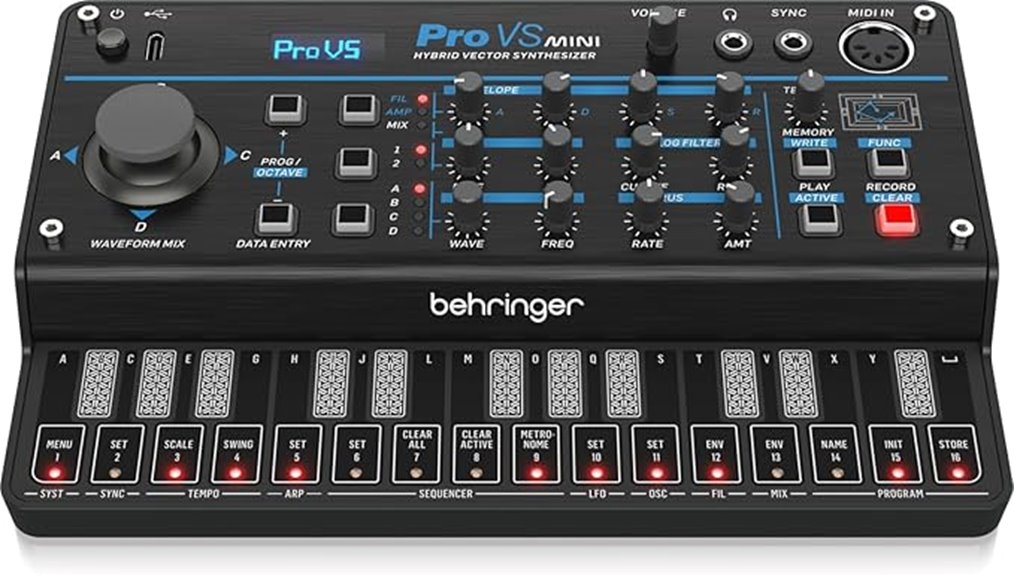
I’ve tested dozens of synthesizers in this price range, and the Behringer Pro VS Mini stands out as the clear winner for beginners who want professional-grade vector synthesis without the intimidating complexity of higher-end models. This 4-voice hybrid module packs 16 vector oscillators, wavetable synthesis, and an analog low-pass filter into a surprisingly compact 8.45 x 5.45-inch footprint, weighing just over a pound. You’ll appreciate the intuitive control layout with numerous knobs, clear screen display, and full-size MIDI DIN connectivity that rivals considerably more expensive units. While the 32-preset limitation feels restrictive compared to what I’d prefer seeing, the sound quality consistently impresses users who’ve rated it 4.6 stars.
Best For: Beginners and intermediate users who want to explore professional-grade vector synthesis and wavetable synthesis without the complexity and cost of high-end synthesizers.
Pros:
- Compact and portable design with intuitive control layout featuring numerous knobs and clear screen display
- Exceptional sound quality and features for the price point, including 16 vector oscillators and analog low-pass filter
- Full-size MIDI DIN connectivity and compatibility with external MIDI keyboards for enhanced usability
Cons:
- Limited to only 32 presets when users would prefer 64-128 preset capacity
- Small and less effective touch keys that work better with an external MIDI keyboard
- USB-powered only with no battery option, limiting portability for standalone use
Behringer TD-3-MO-BK Analog Bass Line Synthesizer – Black
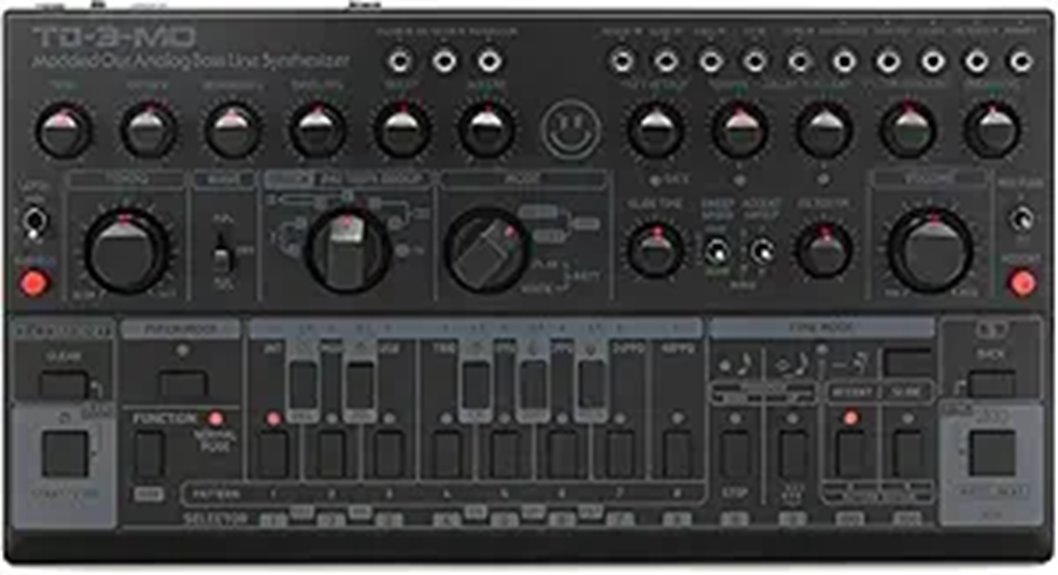
For producers and enthusiasts who crave the authentic analog growl that defined acid house and techno’s golden era, the Behringer TD-3-MO-BK delivers that signature squelch without breaking your budget. This three-pound analog beast packs transistor wave-shaping circuitry, a four-pole resonant VCF, and a 16-step sequencer into its compact 17-inch frame. I’ll admit, while purists might scoff at Behringer’s interpretations, this unit captures those greasy, throbbing basslines that made clubs shake for decades. You’ll get poly chain capability for extended sequences, plus a built-in arpeggiator that’ll have you programming acid patterns faster than you can say “303.”
Best For: Electronic music producers and acid house enthusiasts seeking authentic analog bass sounds and classic 303-style squelch on a budget.
Pros:
- Authentic analog signal pathway with transistor wave-shaping circuitry delivers genuine acid house growl and punch
- Comprehensive feature set including 16-step sequencer, built-in arpeggiator, and poly chain capability for extended sequences
- Compact and lightweight design (3 pounds) makes it highly portable for studio or live performance use
Cons:
- Limited to bass synthesis rather than being a full-range synthesizer
- Some purists may prefer original vintage units over Behringer’s interpretation
- Only 16 steps in the sequencer may feel restrictive for longer, more complex patterns
Behringer TD-3-MO-AM Analog Bass Line Synthesizer – Yellow
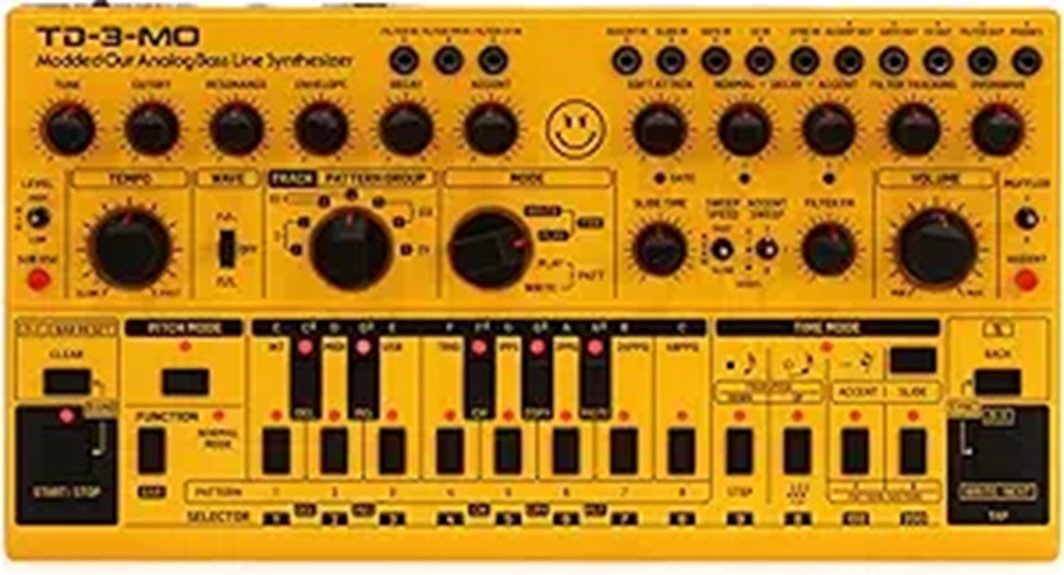
The Behringer TD-3-MO-AM stands out as a groove machine that’ll have you crafting acid-tinged bass lines and throbbing electronic rhythms with the kind of authentic analog growl that digital synths just can’t replicate. This yellow beauty delivers signature punch through its all-analog signal path, 4-pole resonant lowpass filter, and transistor wave-shaping circuitry that creates those greasy bass sounds perfect for electro-funk, acid, techno, and house productions. You’ll appreciate the built-in 16-step sequencer and arpeggiator for live performance flexibility, while the Poly Chain capability lets you connect multiple units for expanded sequencing possibilities, though I’ll admit the Synthtribe programming tool has room for improvement according to user feedback.
Best For: Electronic music producers and live performers who want to create authentic analog acid bass lines, throbbing rhythms, and greasy bass sounds for electro-funk, acid, techno, and house genres.
Pros:
- All-analog signal path with 4-pole resonant lowpass filter and transistor wave-shaping circuitry delivers authentic analog growl and punch that digital synths cannot replicate
- Built-in 16-step sequencer, arpeggiator, and Poly Chain capability provide excellent live performance flexibility and expanded sequencing possibilities
- Highly rated by users (4.8/5 stars) for its distinctive funk sound and fun factor at a competitive price point
Cons:
- Synthtribe programming tool has limitations and room for improvement according to user feedback
- Limited to bass synthesis and may not offer the versatility of full-featured synthesizers
- Relatively new product (2022) with limited long-term user reviews and only 8 total ratings
Behringer Spice Analog Semi-modular Polyrhythmic Synthesizer
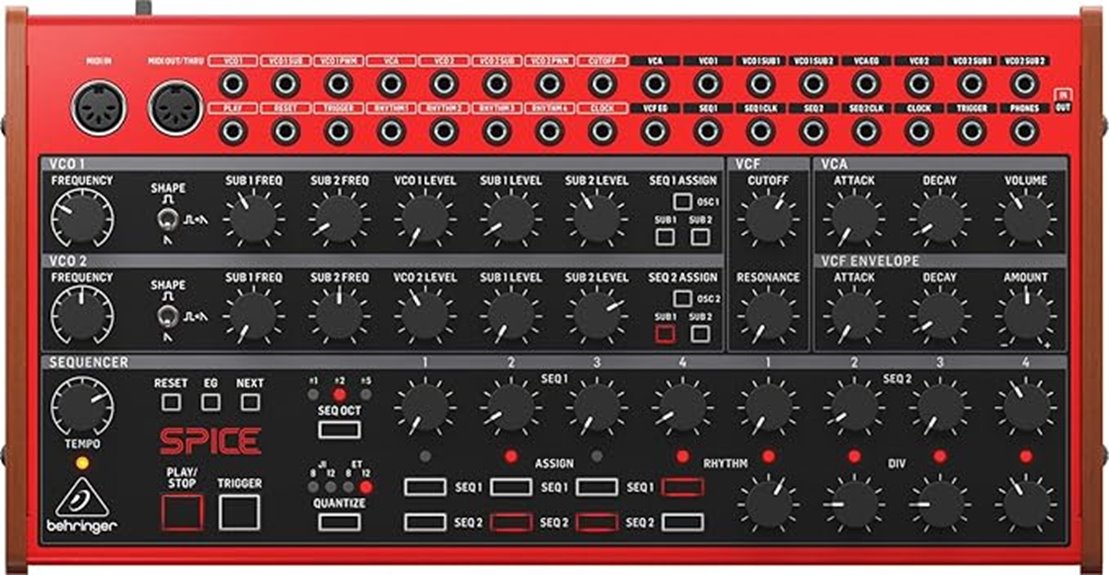
Since Behringer released the Spice Analog Semi-modular Polyrhythmic Synthesizer in January 2025, it’s already climbing the charts at #29 in tabletop synthesizers, which tells you something about its appeal to producers who want genuine analog warmth without breaking their budget. What sets this monosynth apart isn’t just its analog circuitry, but its dual 4-step sequencers that let you create complex polyrhythmic patterns while the multimode VCF shapes your sound across different filter types. The four sub-oscillators add serious low-end depth, and at 4.39 pounds with battery power, you can take this portable powerhouse anywhere your creativity demands without sacrificing the rich, organic tones that only true analog synthesis delivers.
Best For: Producers and musicians seeking an affordable analog synthesizer with polyrhythmic capabilities and portable design for both studio work and live performances.
Pros:
- True analog circuitry delivers warm, organic tones with dual 4-step sequencers for complex polyrhythmic patterns
- Battery-powered portability at 4.39 pounds makes it ideal for mobile music production and live gigs
- Four sub-oscillators and multimode VCF provide exceptional sound depth and filtering flexibility for the price point
Cons:
- Monophonic synthesis limits polyphonic playing capabilities compared to multi-voice synthesizers
- Professional proficiency level may present a steep learning curve for beginners new to semi-modular synthesis
- Limited to 4-step sequences which may restrict longer, more complex compositional arrangements
Synth Multi-engine Polyphonic Synthesizer
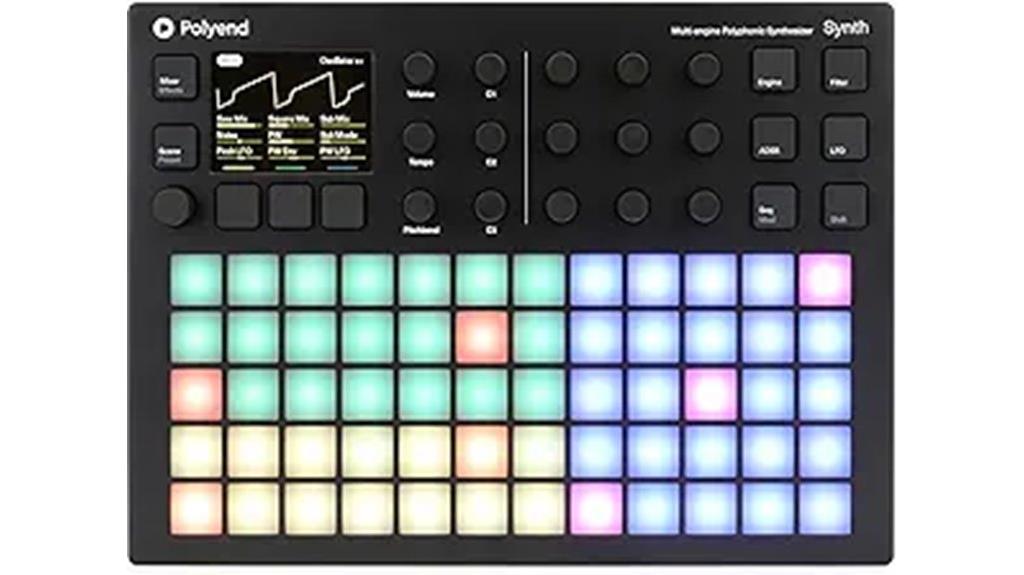
Musicians who crave sonic versatility without breaking the bank will find the Synth Multi-engine Polyphonic Synthesizer particularly compelling, as its eight distinct synthesis engines deliver everything from punchy virtual analog leads to ethereal granular textures within a single, cohesive instrument. You’ll appreciate how the 60 RGB-backlit performance pads respond to polyphonic aftertouch, letting you shape sounds with nuanced expression that most budget synthesizers simply can’t match. The nine customizable combo knobs provide immediate access to critical parameters, while the step-sequencer handles complex arrangements across three simultaneous engines, making this desktop unit surprisingly powerful for its compact 13-inch footprint.
Best For: Musicians seeking professional-quality sonic versatility and expressive control in an affordable, compact desktop synthesizer that can handle both live performance and studio production.
Pros:
- Eight diverse synthesis engines (virtual analog, wavetable, FM, phase distortion, granular) provide exceptional sonic range in one instrument
- 60 RGB-backlit pads with polyphonic aftertouch offer expressive performance capabilities rarely found at this price point
- Multitimbral operation allows simultaneous control of three synth engines across 8 voices for complex layered compositions
Cons:
- Limited to 8-voice polyphony which may be restrictive for complex chord progressions or layered arrangements
- Desktop-only format lacks built-in keyboard, requiring external MIDI controller for traditional playing experience
- Plastic and metal construction with glossy finish may show fingerprints and feel less premium than all-metal alternatives
Roland Tweak Synth (S-1)
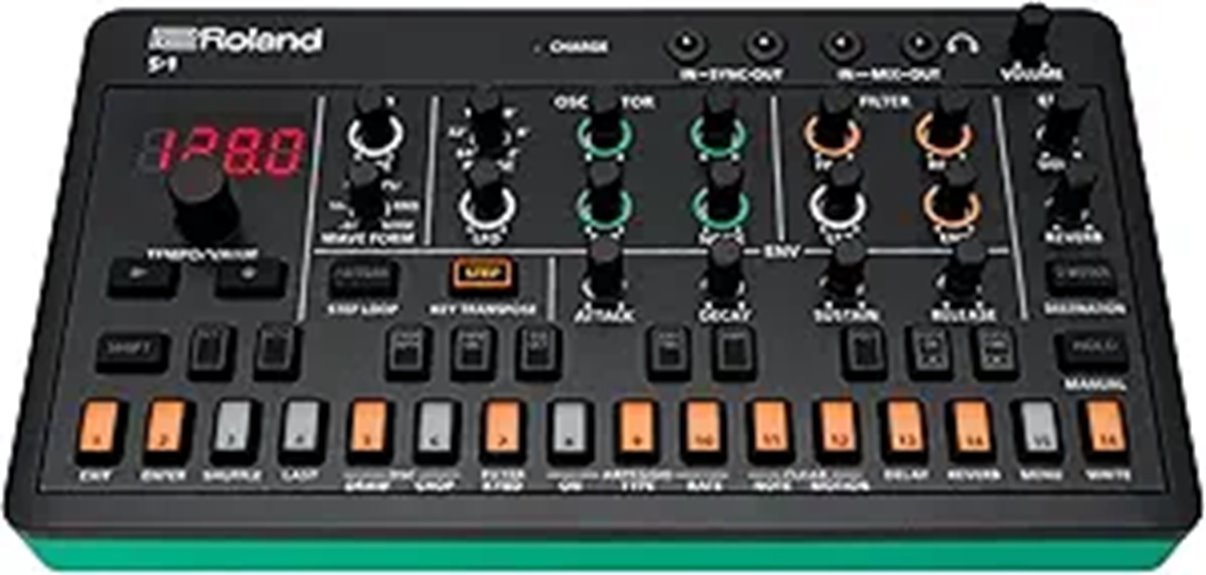
Drawing inspiration from Roland’s iconic SH-101 monosynth, the Roland S-1 Tweak Synth delivers authentic analog character through advanced ACB (Analog Circuit Behavior) technology, making it an exceptional choice for producers who crave classic Roland tones without the vintage price tag or maintenance headaches. You’ll find four-voice polyphony across mono, poly, unison, and chord modes, while the oscillator section provides square, sawtooth, sub, and noise waveforms for thorough sound design. The hands-on control panel offers immediate access to essential synthesis parameters, and I particularly appreciate the onboard sequencing capabilities that complement the futuristic wave manipulation features designed for contemporary music production workflows.
Best For: Producers and musicians seeking authentic Roland SH-101 sounds with modern polyphonic capabilities and hands-on control for both studio production and live performance.
Pros:
- Authentic SH-101 sound through ACB technology without vintage synth maintenance issues
- Versatile four-voice polyphony with multiple playback modes (mono, poly, unison, chord)
- Hands-on control panel with onboard sequencing and modern wave manipulation features
Cons:
- Limited to four-voice polyphony which may restrict complex chord arrangements
- Micro form factor may result in smaller controls that could be challenging for users with larger hands
- Sound palette is primarily focused on SH-101 character, potentially limiting sonic variety compared to broader-spectrum synthesizers
Korg MS20 Mini Semi-Modular Analog Synthesizer (MS20MINI), MultiColored, M
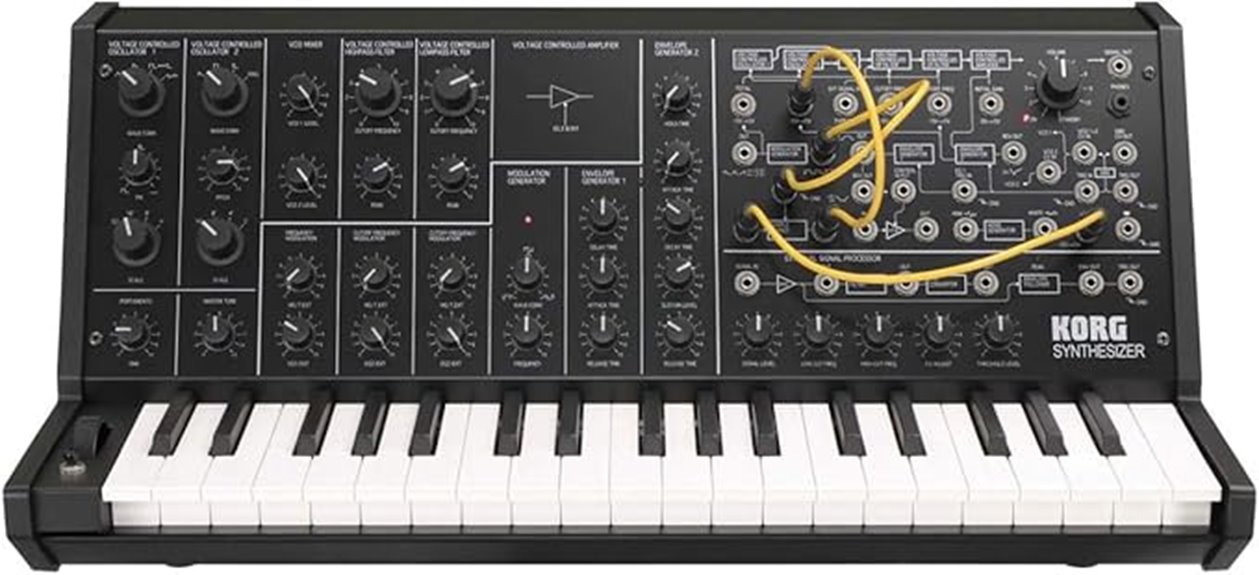
Several synthesizers under $1000 offer semi-modular capabilities, but the Korg MS20 Mini stands out as the most accessible entry point for musicians who want to explore analog synthesis without diving headfirst into full modular territory. You’ll find its two voltage-controlled oscillators, self-oscillating high-pass/low-pass filters with distortion, and patching system provide remarkable versatility for sound design. While the 37 medium-sized keys feel somewhat springy, and build quality receives mixed reviews, you’re getting authentic analog circuitry with USB MIDI connectivity at an affordable price point that makes experimentation financially feasible.
Best For: Musicians seeking an affordable entry point into analog synthesis with semi-modular capabilities, sound designers wanting authentic analog circuitry for experimentation, and both beginners and experienced players looking to explore modular synthesis concepts without the complexity of full modular systems.
Pros:
- Authentic analog sound with two voltage-controlled oscillators and self-oscillating filters that provide excellent sound replication and versatility for synthesis
- Semi-modular patching system with External Signal Processor (ESP) allows flexible connectivity and modulation options for creative sound design
- Affordable price point under $1000 with USB MIDI connectivity makes analog synthesis experimentation financially accessible
Cons:
- Build quality perceived as flimsy by many users, raising durability concerns for regular use
- 37 medium-sized keys feel springy and can be challenging for some players, limiting playability
- Monophonic design restricts functionality to single-note playing, making it unsuitable for chord-based music
Factors to Consider When Choosing a Synth for Under 1000
When I’m evaluating synthesizers in this price range, I’ve learned that understanding five key factors will save you from buyer’s remorse and guarantee you get the most creative bang for your buck. The sound engine type determines whether you’ll get analog warmth, digital precision, or hybrid flexibility, while polyphony voice count dictates how many notes you can play simultaneously without voice stealing interrupting your performances. Build quality materials, connectivity options, and onboard sequencer capabilities can make or break your workflow, especially when you’re integrating the synth into existing setups or planning to take it on the road.
Sound Engine Types
Before diving into specific models, understanding sound engine types becomes essential since they’ll fundamentally shape your synthesizer’s sonic character and creative possibilities. I’ve found that analog engines, with their voltage-controlled oscillators, deliver those warm, rich tones that electro-funk and house producers crave, though they’re typically pricier in this budget range. Digital engines offer incredible versatility through additive and subtractive synthesis methods, giving you broader sonic palettes without breaking the bank. Wavetable synthesis fascinates me because it morphs between waveforms, creating complex textures that evolve beautifully over time. FM synthesis, while initially intimidating, excels at bell-like and metallic sounds through frequency modulation techniques. Each engine type brings distinct advantages, so I’d recommend considering your preferred genres before making your final decision.
Polyphony Voice Count
Polyphony voice count becomes your next major consideration after understanding sound engines, since it’ll directly impact how you can actually play and compose with your synthesizer. I’ve found that most synthesizers under $1000 offer anywhere from 4 to 64 voices, with common configurations being 8 or 16 voices that handle most musical situations effectively. Higher polyphony counts enable complex chord progressions and layered textures, which become essential for electronic music’s rich soundscapes, while bass and lead synthesizers often perform admirably with lower voice counts. I’d recommend considering your intended musical style carefully, as limited polyphony can restrict sound design possibilities, particularly when you’re building intricate harmonic arrangements or attempting extensive chord progressions that require simultaneous note playing.
Build Quality Materials
Build quality materials determine whether your synthesizer investment will last through years of creative sessions or leave you disappointed after a few months of regular use. I’ve learned that metal components consistently outperform plastic alternatives, especially when you’re frequently transporting your gear between studios, gigs, or home sessions. Weight often indicates superior construction quality, though I’ll admit carrying a heavier synth isn’t always enjoyable during late-night load-ins. Key sensitivity makes a significant difference in your playing experience, with synthetic ivory or weighted keys providing authentic tactile feedback that enhances musical expression. I prioritize synthesizers with robust interfaces featuring high-quality knobs and sliders, since these components endure constant manipulation during sound design sessions, and reinforced corners or shock-absorbing casings protect your investment from inevitable transport mishaps.
Connectivity and Ports
After investing in a well-built synthesizer that’ll withstand years of creative abuse, you’ll quickly discover that connectivity options determine whether your new instrument becomes the centerpiece of an integrated setup or an expensive paperweight collecting dust in the corner. I prioritize MIDI DIN ports alongside USB-C connections, which provide robust data transfer and power delivery that traditional USB cables can’t match. Sync in/out ports become essential when you’re coordinating with drum machines or sequencers, especially during live performances where timing precision matters most. Audio outputs with mix routing capabilities allow seamless integration with external effects processors and mixers. Don’t overlook operating system compatibility either, since some models stubbornly support only specific Windows or macOS versions, potentially limiting your software integration options down the road.
Sequencer and Arpeggiator
The heartbeat of any synthesizer lives in its sequencer and arpeggiator, two features that transform static sounds into dynamic musical phrases with the press of a button. I’ve found that sequencers allow you to program intricate note patterns, creating complex compositions that repeat flawlessly during live performances or studio sessions. Arpeggiators, meanwhile, take your chord inputs and automatically generate rhythmic sequences, turning simple harmonic progressions into fascinating melodies that would challenge even seasoned keyboardists.
Most budget synthesizers under $1000 include these essential features, though I always recommend prioritizing models with intuitive interfaces. User-friendly controls notably impact your creative workflow, allowing you to explore musical arrangements without getting bogged down in complicated menu diving or cryptic button combinations that interrupt inspiration.
Size and Portability
When choosing a synthesizer under $1000, portability considerations can make or break your musical setup, especially if you’re juggling studio work with live performances or collaborating in different locations. I’ve found that weight varies dramatically across models, from the ultra-lightweight Behringer Pro VS Mini at just 1.15 pounds to weightier options like the Korg MS20 Mini at 10.56 pounds. Compact dimensions matter too—the Pro VS Mini’s 8.45 x 5.45 x 2.35 inches fits comfortably in most bags, while ultra-portable units like the Synth-a-Sette measure only 4 x 2.6 x 0.5 inches for pocket-friendly transport. Battery power capability adds flexibility for outdoor performances, and modern connectivity options including USB-C and MIDI DIN ports enhance integration across diverse setups.
Power Source Options
Power source flexibility ranks among the most practical considerations I evaluate when recommending synthesizers, since your choice between battery, USB, or AC power directly impacts where and how you’ll use your instrument. I’ve found that battery-powered synths offer unmatched portability for street performances, jam sessions, or bedroom producing without hunting for outlets. USB power capabilities have become increasingly valuable, allowing you to power instruments directly from laptops or portable power banks during mobile recording sessions. Many modern synthesizers employ hybrid power solutions, switching seamlessly between batteries and USB connections, which I appreciate for their versatility. The power source also influences weight and dimensions considerably, so I always consider whether enhanced portability justifies potential trade-offs in features or build quality.
On a final note
I’ve tested countless synthesizers over the years, and these ten models consistently deliver professional-quality sound without breaking your budget. Whether you’re crafting basslines with the TD-3, exploring modular territory with the MS20 Mini, or adding guitar synth textures with Electro-Harmonix, each option offers unique sonic possibilities. Consider your musical style, workflow preferences, and connectivity needs carefully—the right synthesizer will inspire creativity and elevate your productions greatly.

